Introduction
When prosecutors approached a first-time drug offender who had sold a little over half a kilogram of marijuana, they offered him a deal: plead guilty to fifteen years, or take the case to trial and risk worse.1 They “stacked” twenty charges against him to maximize his sentence.2 Each additional charge under 18 U.S.C. § 924(c) imposes a mandatory minimum of twenty-five years.3 That is, twenty-five years consecutively.4 In this defendant’s case, charge stacking threatened over 100 years of imprisonment.5 The defendant took his chances with the jury. He was not successful at trial: the jury convicted him of thirteen counts and sentenced him to fifty-five years in prison, eligible for release at age eighty.6 Then-Senator Jeff Sessions, a prominent conservative on criminal justice issues, noted that “the stacking issue is a problem.”7
This is charge stacking. It is not a new phenomenon. It can happen to any defendant, regardless of social class or era. Examples date back to the 1800s. In the 1800s, some defendants failed to keep the town’s streets clean, so officials charged them three or four times, once for each street.8 In another case, the government prosecuted unlicensed alcohol retailers using one misdemeanor per sale, effectively procuring a life sentence.9 In the modern era, celebrity chef and businesswoman Martha Stewart’s five-count indictment for a “tenuous” case of lying about insider trading has led some academics to call for a limiting “law of counts” more broadly.10 Charge stacking can also extend to common street crime and drug offenses.11 A prosecutor can convert stealing a motor vehicle, a typical street offense, into more charges to include “unauthorized use of a vehicle and possession of stolen property.”12 Although not entirely a “street” offense, a goat farmer who accidentally let his goats trespass faced 170 misdemeanors — one for each goat — and up to sixty years in prison.13 His case, though, hailed not from the nineteenth century, but from 2004.14 Charge stacking is not new, and it can happen to anyone — no one is safe from the risk that government can “divide crime and multiply punishment.”15
As commonly understood by academics, advocates, and the public, this practice is pernicious, pervasive, and prejudicial to defendants’ rights.16 In this narrative, prosecutors charge overlapping and duplicative offenses to build pressure against criminal defendants when fewer charges would suffice and more accurately capture defendants’ culpability.17 Whether federally or in the states, charge stacking results in more plea bargains, undergirded by diminished chances at trial due to extra charges against defendants.18 Large swathes of criminal defendants thus crumble beneath tall piles of charges, both federally and in the states.
However, this common understanding of charge stacking is incomplete, mostly anecdotal, and needs empirical study. Until now, though, data on charge stacking across states and the federal government have been unavailable. This Note has new data from nationwide aggregators of federal and state charging data that prior research has not previously linked together. With these data, this Note provides two key findings worthy of further research:
(1) Some states charge more offenses per defendant and do so more often than the federal government.
(2) Regardless of jurisdiction, more charges correlate with higher rates of conviction.
First, this Note describes the basic rules of criminal procedure permitting a single case to have many criminal charges, and criticisms of that result. Then, it describes theories on why more charges might unfairly promote more criminal convictions. That understanding of charge stacking, this Note argues, is incomplete.
From there, this Note moves on to the data. It begins by describing the sources of federal and state data and the methodology. Analysis begins with federal data as context to ultimately compare with data from Arkansas, Pennsylvania, Florida, and Tennessee. The state data demonstrate that the examined states not only charge millions of offenses more than the federal government; they also face the same, if not worse, associations between charging multiple offenses and criminal defense outcomes, particularly guilty pleas and guilty verdicts. Finally, this Note calls for more research. Some variables — race, gender, and type of crime — are either not comprehensive or not available. Importantly, though the data are consistent with charge stacking, they do not prove it. Because this analysis suggests negative criminal justice outcomes based on the number of charges, but the available data are limited, more study should delve further into the prevalence and causes of charge stacking.
A. How Charge Stacking Works
The Federal Rules of Criminal Procedure19 and all their state counterparts20 permit prosecutors to charge multiple offenses — officially known as “charge joinder” — by joining multiple counts of a crime upon a single defendant. The rules enable prosecutors to charge a criminal defendant by overlapping or duplicating offenses and then, after pressure on the defendant looms, agree to reduce the charges in number or in severity in exchange for a guilty plea.21 Using this leverage, prosecutors can threaten a “trial penalty” by going to trial with all of the charges, even if exaggerated.22 Charge stacking works because the breadth of criminal law probably means any one criminal episode constitutes multiple crimes.23 A burglary, after all, is trespassing, too.
B. Charge Stacking Is Criticized
Some observers describe charge stacking as a phenomenon endemic to the discretion available to prosecutors, a “regular occurrence that is part of a prosecutor’s leverage,” and a practice that has been increasing in usage since the creation of three-strikes laws.24 It often involves charging “overlapping, largely duplicative offenses.”25 Charge stacking as a practice has been described as not only malignant but rampant, with others observing that “[t]urning one crime into many is easily done,”26 where drug offenses with conspiracy bring along “gun use, money laundering, and a laundry list of other charges altogether.”27
Others see in powerful stories the pervasiveness of charge stacking in each level of the criminal justice system. If charge stacking is taken to its limit, one criminal justice scholar worried, “we are likely to come ever closer to a world in which the law on the books makes everyone a felon.”28 Charge stacking, in a phrase, “throws the book” at criminal defendants. The point is not whether a case as absurd as 170 at-large goats would ever go to trial — the district attorney, after much controversy, dropped the charges.29 Nor would anyone seriously allow a criminal to snag a bargain and commit one crime, get one free. Rather, the concern is that “[w]hen the government wants to impose exceptionally harsh punishment on a criminal defendant,” it can “divide crime and multiply punishment.”30
C. Charge Stacking Worsens Defendants’ Chances
In theory, prosecutors stack charges because it works: multiple charges significantly increase guilty verdicts.31 Accounting for a host of variables, empirical legal research has demonstrated that multiple criminal charges significantly raise the odds of a guilty verdict by more than 10%.32 The effect increases with the number of charges,33 and the weaker the government’s case, the stronger the effect multiple charges have.34 The effect multiple offenses have on defendants begins before trial and before plea bargaining in some jurisdictions where “each additional charge,” within the discretion of the prosecutor, brings “a commensurate bond obligation, meaning that defendants are more likely to be sitting in jail pre-trial and unable to help their defense attorney.”35 This, too, could potentially raise rates of guilty pleas and verdicts. Commonsense theories have considered why multiple charges lead to these outcomes. The greater the number of counts, the greater the jury’s suspicion of criminality.36 Further, counts that may be considered weak “may assume greater authority.”37 If a defendant arrives at trial with a dozen counts in tow, the jury may judge the case to be especially serious, worthy of punishment in and of itself. Jurors may see the evidence as cumulative even for the separate crimes and convict even “when [they] would not convict him of either if [they] could keep the evidence properly segregated.”38
Imagine a piece of evidence admitted into trial for a robbery count alone but not admitted for the trespassing component. Separating the issues may be difficult for juries to do. A defendant may also suffer special difficulty when “he desires to assert his privilege against self-incrimination with respect to one crime but not the other.”39 It hardly helps the defendant’s aura of innocence in a lay juror’s eyes when the defendant pleads the Fifth on robbery but not trespassing, or on bank fraud but not wire fraud. Jurors may compromise to meet in the middle in the deliberation room by finding the defendant guilty on some but not all charges;40 jurors also become more likely to confuse and combine evidence from separate charges in a single trial;41 and “proof that the defendant is guilty of one offense may be used to convict him of a second offense, even though such proof would be inadmissible in a second trial for the second offense.”42 A particularly trusting attorney may have faith in the jury’s wisdom to consider each count’s evidence separately through a jury instruction, but — really — “all practicing lawyers know [that] to be unmitigated fiction.”43
Criminal justice professionals, commentators, and academics recognize these effects and bemoan charge stacking in the United States as pervasive and rampant.44 The American Bar Association once warned prosecutors against “‘piling on’ charges in order to unduly leverage an accused to forgo his or her right to trial.”45 Now, criticism has intensified from broader constituencies: charge stacking has been listed among the American prosecutor’s “fearsome array of tools . . . to extract confessions and discourage people from exercising their right to a jury trial.”46
D. The Common Understanding Is Incomplete
This understanding of charge stacking, often anecdotal, is incomplete. Its criticisms do not distinguish between the criminal justice systems of the states and the federal government. But charging multiple offenses is not uniform across the United States.47 Data show that charging multiple offenses does not occur nearly as often in the federal justice system as common understandings suggest.48 However, early data do provide evidence consistent with charging multiple offenses being more common in at least some states.49 Perceptions of prejudice to defendants, on the other hand, find support in the data. Federal criminal charging data show that the more charges filed, the more likely the defendant loses at trial.50 Again, too, early state data suggest that not only does charging multiple offenses occur more often in some states; it also correlates with worse outcomes for criminal defendants.51
In the past, despite analysis of charge stacking and concerns from criminal justice activists, much literature either focused on multiple charges at the jury-trial level in the abstract,52 or focused exclusively on the federal level.53 This scholarship mostly comes from the 1980s to the early 2000s.54 Rarely do analyses extend beyond anecdotal accounts.55 Those that do focus on the history of charge stacking before the twentieth century.56
Updated empirical data on charge stacking can help provide clarity to story-driven advocacy. Criminal justice policy often suffers from a degree of anecdotalism that prevents targeted reforms from producing movement on criminal justice issues.57 The problem with “sound-bite, story-driven” approaches to reform is that “our system is not just the sum of the stories that you hear about.”58 These approaches prevent the “public and politicians” from seeing “the sweep of the criminal law and the criminal system,” causing them to fail to “focus on the details or analyze how limited pools of money should be spent.”59 To determine whether advocates should pursue reducing the effects of charge stacking, one must first understand how often charging multiple offenses occurs, where it occurs, and if there are associated effects on defendants’ outcomes. This analysis will focus on the details beyond “story versus story.”60 At the very least, a clearer picture clarifies the environment of debate.
I. Methodology
A. Datasets
Few institutions can track all charges in any criminal justice system — state or federal — much less charges in both systems.61 The federal and state criminal justice systems are so huge and make available such little comprehensive data that legal researchers struggle to compare numbers between them.62
This Note makes progress on dissolving these practical barriers. Its analysis primarily relies on two nationwide aggregators of criminal defendant data: Syracuse University’s Transactional Records Access Clearinghouse (TRAC) and Measures for Justice.63 TRAC provides federal criminal defendant data.64 TRAC data show defendants’ ultimate outcome in the federal justice system — guilty plea, trial conviction, dismissal, or otherwise.65 The federal dataset covers every federal criminal charge filed since at least 2004.66 At the state level, this Note uses data from Measures for Justice.67 Measures for Justice has agreements with state judicial systems to provide similarly comprehensive lists of charges filed for state defendants.68 This Note will use the state dataset to show charging data from Arkansas, Florida, Pennsylvania, and Tennessee from 2009 to 2013.
Neither of these datasets is widely available. Outside of federal government sources, TRAC is among the few sources of comprehensive federal charging data. Prior to Measures for Justice’s partnerships in many states, the data did not exist at all, locked away in cold electronic storage or even paper records.69 At the time of writing, neither TRAC nor Measures for Justice has released charge-stacking data publicly on their platforms.70 Drawing on the unique contributions of these sources, this Note performs the first-ever quantitative comparison of charge stacking across the state and federal levels.
B. Federal Methodology
At any given time in the criminal justice process, there will be a number representing the highest number of charges that a criminal defendant will ever get. Identifying that moment in time, however, can be challenging. That is because prosecutors can charge a criminal defendant multiple times in a long-running investigation. The charges can come from a variety of charging instruments: Prosecutors may issue a criminal complaint with some number of charges.71 Or they could support that complaint with an “information” approved by a judge or if pleaded to by a defendant.72 A prosecutor may also be legally obligated in felony cases to charge via grand jury indictment.73 This means that in a criminal investigation, depending on the timing, a criminal defendant can have one or many charges for different offenses coming from different kinds of charging documents. It is also possible for a prosecutor to use multiple charging documents to charge a defendant using the same number of charges.
This Note sifts through millions of charges to identify that maximum number. Consider a criminal defendant charged by complaint with three offenses, then charged by information with two offenses, and finally by indictment with two other offenses — albeit an unlikely case. This Note isolates the exact defendant in each case and then identifies the maximum number of charges a defendant would receive earliest on in the criminal justice process.74 This hypothetical defendant would count as having three charges, notwithstanding her prosecutor’s later marshalling charging instruments against her. Choosing the maximum number of charges in this way pinpoints the moment when commentators describe leverage against the defendant as highest due to charge stacking.75 The earliest, largest number of charges reflects charge-number-related pressure that the defendant initially faces.76
C. State Methodology
While TRAC files FOIA requests to the federal government on a rolling basis, Measures for Justice engages in partnerships with many states. Measures for Justice standardizes the data among states and centralizes them for the public’s review.77 This analysis is normally unavailable to the public. At the request of this Note’s author, Measures for Justice has charitably calculated charges and charge stacking custom-made for this project.
Unlike the national dataset, the state dataset identifies the number of charges by criminal cases, not criminal defendants. This means “all charges associated with the same individual defendant that were filed in court . . . on the same date.”78 So, compared to the federal data, which identify a single criminal defendant’s fate across a single criminal case, there is some risk that this will distort the true number of criminal charges a state-level defendant faces. But the data assume that “when a prosecutor files multiple charges together, even when they stem from separate incidents, they intend to resolve these charges simulta-neously.”79 Ideally, then, the distortion will be minimal. This Note treats the federal and state measures comparably and recognizes they are not a perfect match.80
D. Charge Stacking Definition
Because charge stacking normatively happens when charges exceed what the defendant deserves, opinions differ on what number of charges constitutes a “stack.”81 Most people would probably consider 170 charges for trespassing goats patently absurd. In contrast, most people probably could justify multiple charges for mass murder. Between these extremes, charge “stacking,” like a “trial penalty” versus a “plea discount,” is a matter of perspective.82 Importantly, the data alone cannot define what charge “stacking” is. However, they can provide context for that inquiry. Charge stacking, at minimum, requires more than one charge. The greater the number of charges, the more likely one will find charge stacking. Limits to data notwithstanding, this Note provides all the results so the reader can make her own conclusions.
II. Charging Data
A. Federal
For the federal analysis, this Note begins with the number of charges per defendant from 2004 to 2019. The data show that the majority of criminal defendants receive one charge; the minority, two or more. This Note then moves on to show that more charges correlate with higher conviction rates at trial.
1. Number of Charges per Defendant. — Between 2004 and 2019, the federal government prosecuted nearly 500,000 criminal cases, over 2.5 million defendants, and 6.85 million charges. Figure 1 shows that more often than not, prosecutors charged criminal defendants with only one charge.
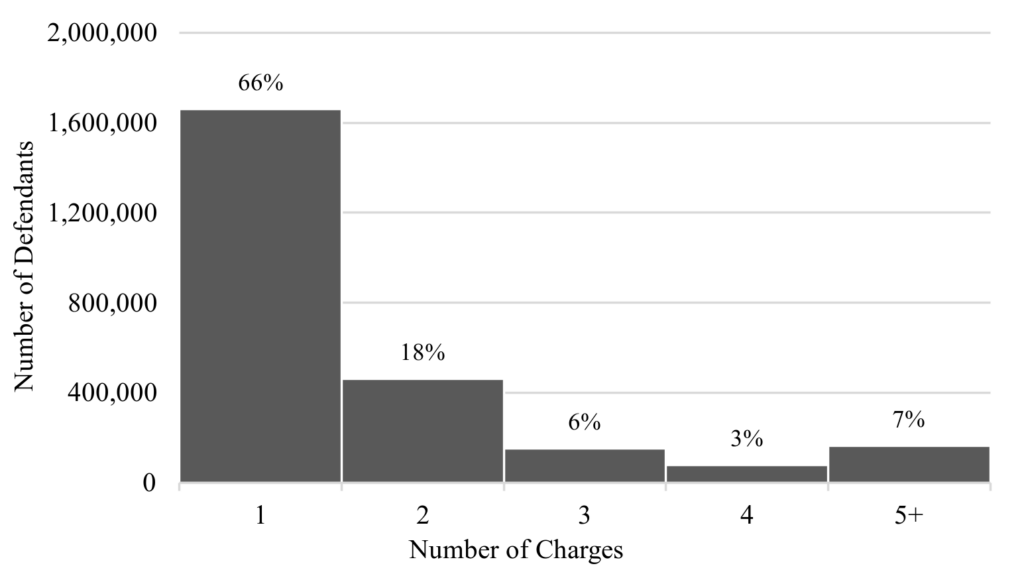
Figure 1 counts the maximum number of federal charges per criminal defendant from 2004 to 201983and includes felonies, misdemeanors, and petty offenses. It also does not discriminate between whether a case pleaded out, went to trial, or was dismissed.
Most of the time, far from charging multiple crimes, federal prosecutors charged defendants with just a single offense (66%). Two charges are in distant second (18%). Both scenarios combined represent over two million prosecutions for a sixteen-year period. Three, four, and five or more charges comprise a minority of defendants’ cases (16%).
It is unlikely that these numbers reflect prosecutors severing criminal cases into multiple charges for multiple trials. The Federal Rules of Criminal Procedure permit either party to motion the court to sever charges when unfairly prejudicial against the defendant,84 yet the data show little indication of this occurring. The federal data stopped tracking severance in the 1990s.85 The lack of federal data on severing charges likely does not indicate that literally no charges were split. Even before the data stopped tracking severance, between 1981 and 1997, the data show that charges were severed only 673 times. Instead, it more likely reflects that severing charges occurs so infrequently that tracking it internally at the federal level is not useful and thus is not represented in the data.
This analysis identifies the highest number of charges prosecutors brought against a criminal defendant. If the results show one charge, that is the largest number of charges a defendant received. But Figure 1 does not capture threats made by prosecutors off the record to charge more offenses if the defendant did not plead guilty early on.86
2. Number of Charges Versus Trial Convictions. — Figure 2 shows that more charges correlate with more criminal convictions at trial.87 The conviction rate is 82% at one charge; for defendants tried for five counts or more, the conviction rate is 91%, almost 10 percentage points higher.
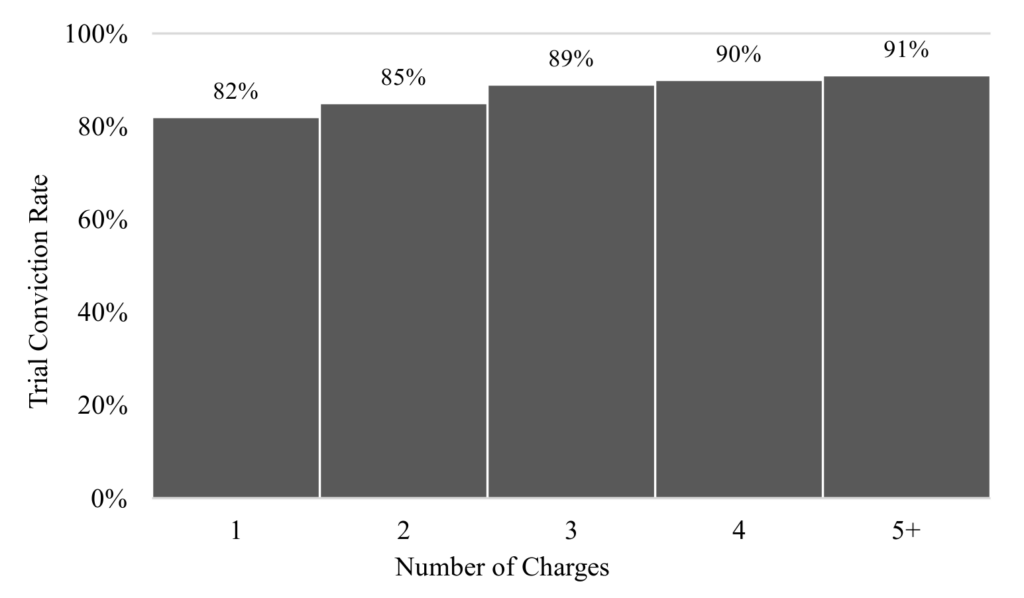
The relationship between the number of charges and guilty-plea rates is difficult to discern. The guilty-plea rate is extremely high; no matter the number of charges, the conviction rate is nearly 100%.88 A comparison among such a uniform sample is not meaningful. Figure 2 makes clear that among those who go to trial, the number of charges correlates with higher conviction rates.
B. States
Having examined the data on potential charge stacking in the federal government, this Note now turns toward the states. Although much criminal justice literature focuses on the federal system exclusively, it does so at its own peril.89 At least one statistic identifies that “about 87 percent of all prisoners are held in state systems,”90 such a large number that “if [the federal government] freed every single federal prisoner in prison today, [the United States] would still have the highest incarceration rate in the world.”91
State criminal justice systems and the federal criminal justice system have material differences. While the “federal criminal code places virtually no constraints on redundant charging,”92 many state governments limit the ability to charge defendants with multiple counts.93 Consequently, evaluating how often states charge multiple offenses helps to examine the practice’s prevalence in the majority of the criminal defendant population.
This section begins with how charge-joinder rules differ between Arkansas, Pennsylvania, Tennessee, Florida, and the federal government. Then, it demonstrates that the four states charge millions more offenses, charge stacking or otherwise, than the federal government. Like the federal data, more charges correlate with worse outcomes for criminal defendants in the states, including higher rates of conviction and guilty pleas.
1. Charging Rules in Arkansas, Pennsylvania, Tennessee, and Florida. — This Note focuses on Arkansas, Pennsylvania, Tennessee, and Florida because each has slightly different laws on when prosecutors can charge multiple offenses at once. Florida allows combining charges when offenses arise from the same event or chain of events;94 this includes granting the defendant the qualified ability to motion to sever remaining charges after she has been tried for only one of them.95 Pennsylvania has a narrower “common-scheme” rule, where multiple offenses can be charged together only if the evidence of each could be used in a separate trial and would not confuse the jury, or the offenses are based on the same transaction.96 Arkansas for some time had the narrowest rule, a one-charge-per-indictment regime, allowing “an indictment to . . . charge but one (1) offense” with some exceptions for crimes like robbery, kidnapping, and “[l]arceny of several animals.”97 That changed in 2005 when Arkansas repealed and replaced it with a similar-charge rule more akin to that in the Federal Rules.98 Tennessee’s rule on combining charges has a mandatory and a permissive component. In Tennessee, combining charges is mandatory when the offenses are based on the same conduct, are within the jurisdiction of a single court, and are “known to the appropriate prosecuting official at the time of the return of the” charging instrument.99 And combining charges is permissive when the charges are merely “parts of a common scheme or plan” or “of the same or similar character.”100
2. Criminal Charges per Defendant in Arkansas, Pennsylvania, Tennessee, and Florida. — The following analysis shows how many charges each state government brought per defendant and how often they did so. It begins with the number of charges per case, proceeds with comparing the number of charges with the trial conviction rate, and concludes by comparing the guilty-plea rate with the conviction rate.
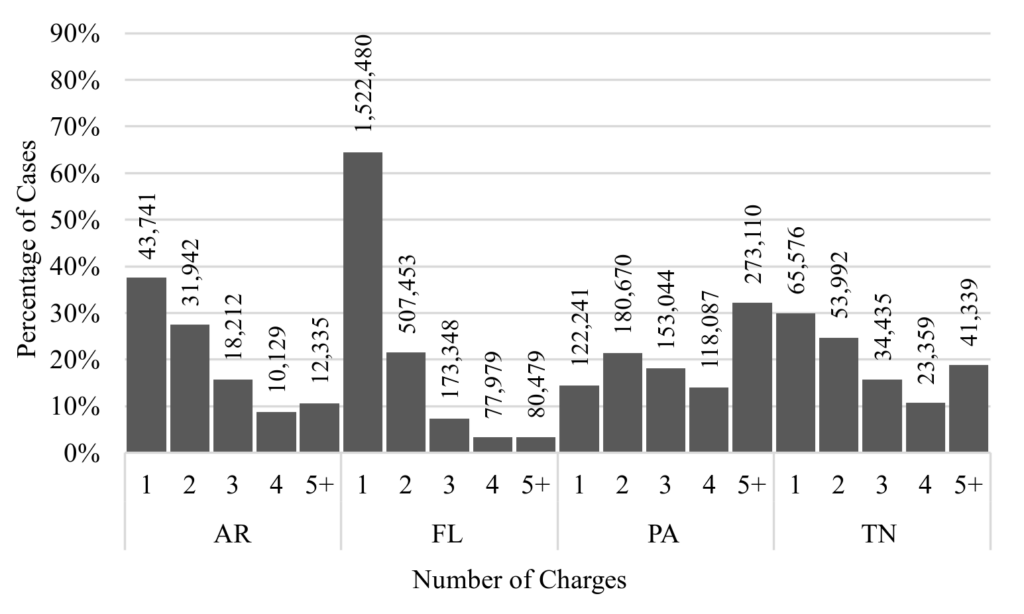
Figure 3 shows what percent of criminal cases have a certain number of criminal charges in Arkansas, Florida, Pennsylvania, and Tennessee. Each bar also indicates the absolute number of cases. In Florida, for example, the majority of criminal cases have only a single charge (64%, 1,522,480 cases). And in Pennsylvania, the majority of cases have two charges or more (86%, 724,911 cases).101 These preliminary results suggest that in some states, multiple-offense cases reflect a minority of cases (Florida), while in others, they reflect a majority (Pennsylvania). States, ever laboratories of democracy, approach charging multiple offenses differently, producing varied outcomes for criminal defendants in each state.
3. When States Charge Multiple Offenses, Those Charges Accompany Higher Rates of Conviction. — Figure 4 shows that for the state data, more charges correlate with a higher rate of guilty verdicts.
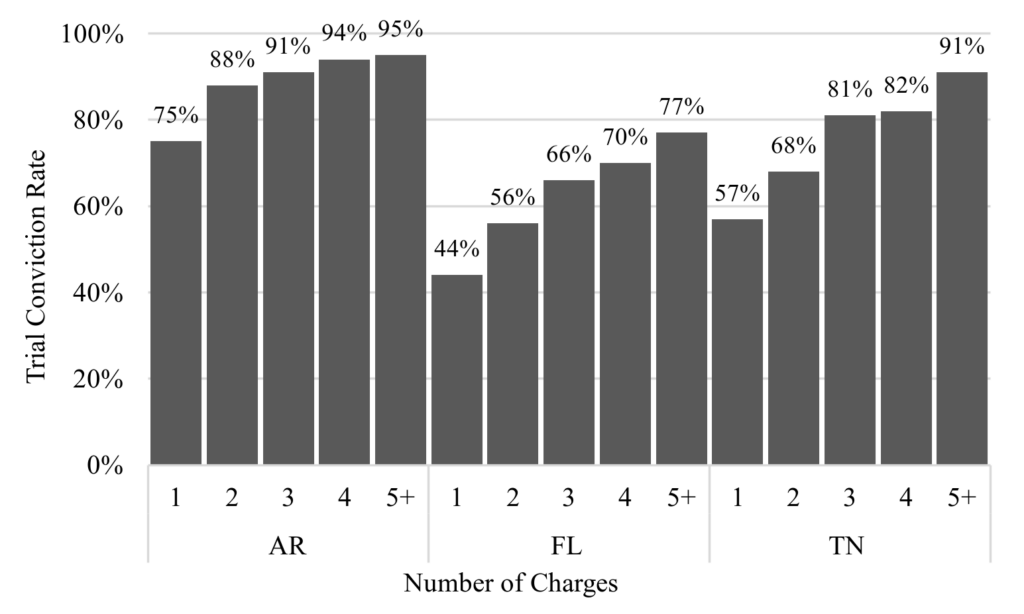
Figure 4 shows what percentage of trials result in guilty verdicts, broken out by number of charges.102 As in the federal system, the increasing trend in trial-conviction rates persists at the state level. In Arkansas, one criminal charge is associated with a 75% trial-conviction rate, and the conviction rate increases with each additional charge to a high of 95% for five or more charges. Tennessee cases begin lower, with 57% convicted where the defendant faces a single charge, and end at a conviction rate of 91% where the defendant faces five or more charges. Florida begins much lower, starting at 44% convicted with only one charge, and topping out at 77% convicted for five or more charges — a rate nearly identical to the trial-conviction rate associated with only one charge in Arkansas.
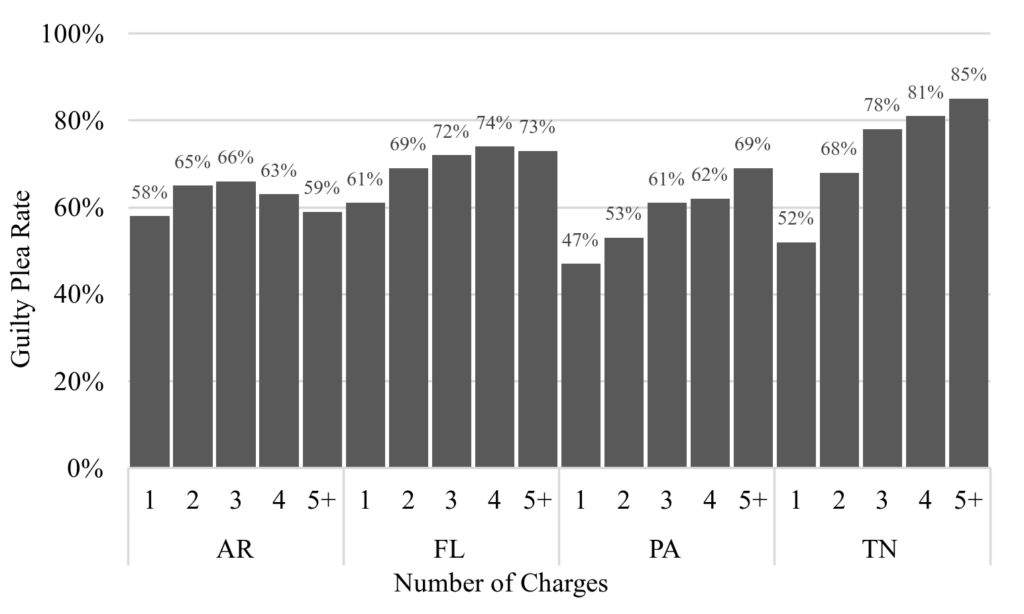
Finally, consider Figure 5, which shows the rate of guilty pleas in all four states, broken out by number of charges.103 With the exception of Arkansas, the states see a positive correlation between the rate of pleading guilty and the number of charges filed in the case. Florida tapers off between four and five charges, but the difference is minimal: 74% for four versus 73% for five or more. For felony cases in Tennessee, guilty plea rates increase sharply with the number of charges. At one charge, the guilty plea rate is at 52%; at five or more, the number jumps to 85%. For most of these examined states, more charges correlate with a higher rate of guilty pleas. As for Arkansas, misdemeanors might account for its rising and falling curve. Additional data from the State of Arkansas’s Office of Research and Justice Statistics show that among criminal defendants charged in circuit court with only misdemeanors, criminal defendants having multiple charges were, surprisingly, less likely than those with one charge to plead guilty by 10 to 20 percentage points every year from 2009 to 2013.104
III. Comparison Between Jurisdictions
An initial finding suggests that charge stacking is both more prevalent — and more effective for prosecutors — at the state level than at the federal level. Federal data from the federal districts encompassing Arkansas, Florida, Pennsylvania, and Tennessee show that prosecutors brought fewer than 70,000 criminal cases and a little under 200,000 charges from 2009 to 2013. Table 1 shows that the cases and charges in each of these states alone rival or greatly exceed how many the federal government pursued across all these states’ respective federal districts combined.
Despite the size of the federal government, each state prosecutes a
Table 2 derives summary statistics for these jurisdictions from 2009 to 2013. The federal values in the table come from the corresponding federal districts for each state.
The federal government charged on average more charges per case in each state jurisdiction surveyed — except Pennsylvania. Pennsylvania charged an average of roughly 50% more offenses per case than the federal districts of Pennsylvania (5.04 versus 3.43). Of course, averages suffer from vulnerability to outlier numbers and to unnatural readings (for example, there is no such thing as 0.43 charges). Additionally, since states prosecute so many more criminal cases, the large number of one-charge cases can weigh down the average and obscure how multiple-charge cases are represented. A more natural way to examine the number of charges might be the median, which provides a whole number. Using the median shows that some states charge a median number of charges multiple times more than the federal government. Florida and Tennessee have a 1:1 state-to-federal ratio of median charges, but Arkansas charges twice as many, and Pennsylvania three times as many, as the median number of federal charges in their respective federal districts. The means and medians combined suggest the following: al-though the federal government charges more charges per case, states charge more cases with multiple charges.
The distribution of charges corroborates the summary statistics. Figure 6 juxtaposes the number of charges per defendant in each state with the corresponding federal district. For example, the federal bar values in Figure 6 encompass the federal Eastern District of Arkansas and the Western District of Arkansas.
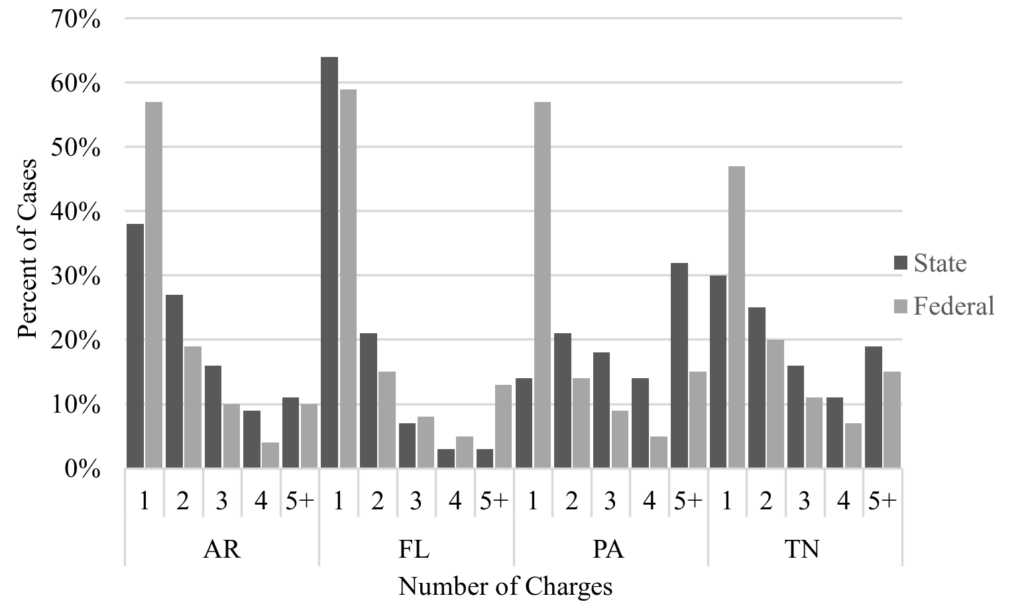
Figure 6 shows that, as a proportion of all cases, Pennsylvania charges criminal defendants with multiple offenses more than the federal district equivalent. The same applies to Tennessee and Arkansas, al-though Arkansas’s five-or-more-charges value is very similar to the federal government’s (11% versus 10%). Florida is an outlier among these states, because its federal districts, when compared to the state government, do prosecute a larger proportion of cases with multiple offenses.
Finally, Figure 7 juxtaposes state conviction rates with those of their corresponding federal districts.
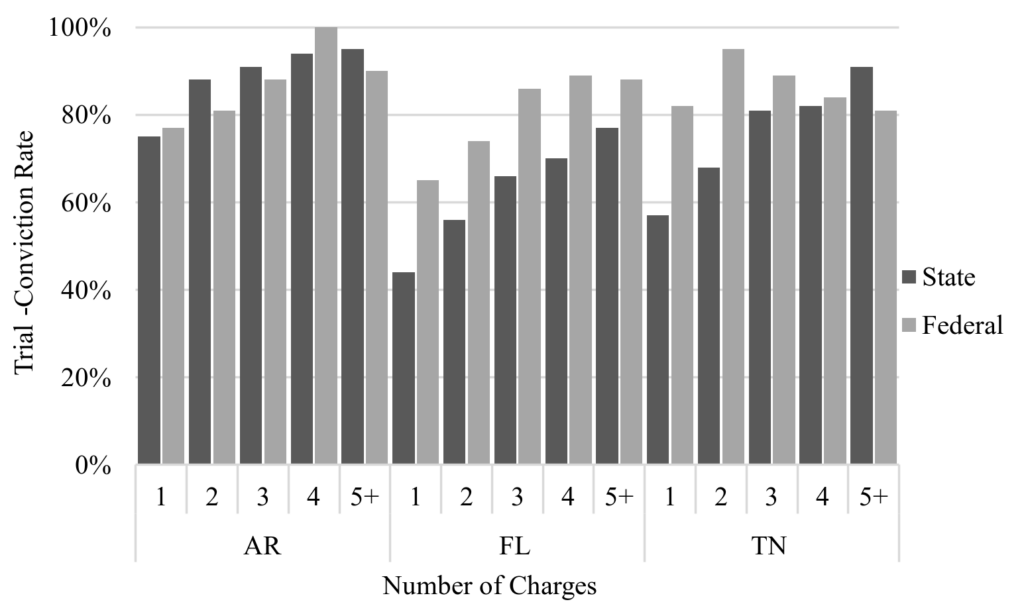
Figure 7 shows that the rate of state-level criminal convictions increases more sharply the more charges the defendant faces. Compared to Arkansas’s federal districts, Arkansas’s state-conviction rates start lower at one charge (75% versus 77%) but end higher, at five or more charges (95% versus 90%), though the data suggest the federal government won all of its trials against defendants with four charges. Florida’s state conviction rate does start lower at one charge (44% versus 65%) but grows more sharply than the conviction rate in Florida’s federal districts, at five or more charges (33 percentage point increase versus 23 percentage point increase). The same applies to a comparison between Tennessee and the federal district courts in Tennessee. State law criminal defendants suffer a sharper increase in convictions between one charge and five or more charges (34 percentage point increase versus 1 percentage point decrease). At five or more charges, Tennessee’s total conviction rate is even higher than its federal equivalent.
All these comparisons suggest that attention to charge stacking might be better directed toward the several states because of the sheer number of criminal defendants affected by state practices of combining criminal charges. Potential reforms would affect far more people who endure increased risk of conviction for multiple offenses.
IV. Limits to Data and Recommendations for Future Study
While this analysis is consistent with charge stacking, it does not prove it. Due to data-access limits, this Note is not a causal study. This Note at most shows an association between more charges and more severe criminal defense outcomes. Further, this analysis alone does not fully explain the data’s central mystery: If prosecutors prefer to convict culpable defendants, and more charges correlate with more guilty results, why does the prosecution not always charge multiple offenses? This is more puzzling considering indictments of any size appear legally straightforward to obtain.107 The data allow alternative explanations. The government might simply levy multiple charges when the defendant is accused of engaging in multiple culpable criminal episodes or many offenses to cover each aspect of a uniquely strong case — in other words, the government might seek the “fair” amount of charges. Or, perhaps, the length of sentence for a few charges is so high that more charges are simply unnecessary. Alternatively, the defendants could be threatened with more charges unless they plead guilty — and hence they do — so charges never appear in the data. Without directly perusing the millions of indictments, informations, and complaints initiating each prosecution in the data, this analysis cannot evaluate how the number of charges relates to the justness of the case or the prison time the defendants face. Further empirical study should evaluate alternative explanations.
Conclusion
Criminal justice scholars are concerned about charge stacking in the criminal justice system. The most current data indicate that charging multiple offenses in the federal system does not occur nearly as often as public commentary and the trial advantage suggest. Instead, in at least some states, the state government charges multiple offenses more often than the federal government does, a practice that correlates with higher rates of conviction. The association between more charges and higher conviction rates remains present federally and in the states.
This Note demonstrates that still more research into charge stacking is needed. Importantly, comprehensive data on how race and gender interact with the number of charges are missing from both the federal and state datasets. Nor do the state datasets provide information broken out by type of crime. Likewise, the data do not represent every state in the country. The public would benefit from a nationwide dataset. Additional research reflecting more states, more offenses, and more demographic data such as race and gender should further uncover the potential prevalence and causes of charge stacking.